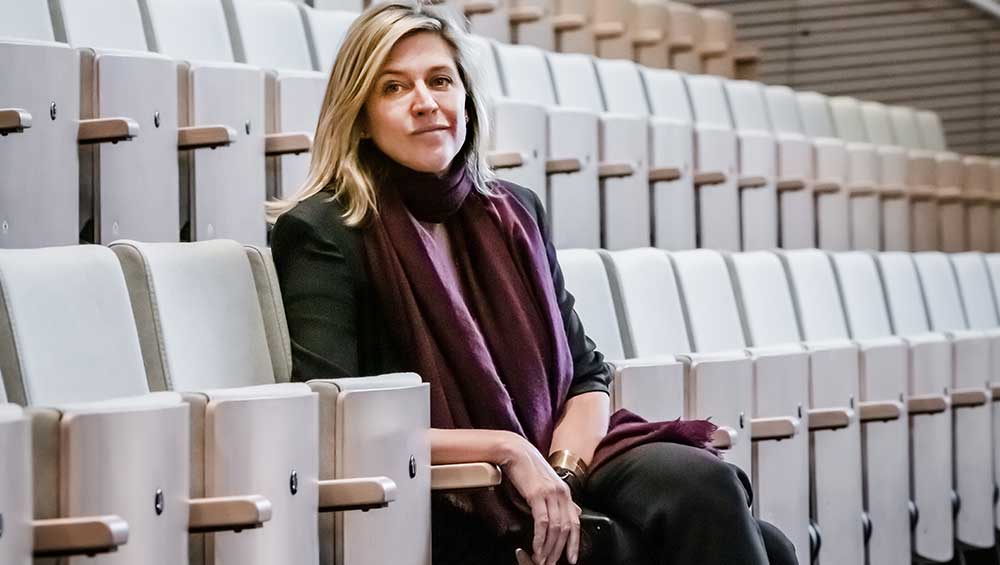
Christina Seilern. Photo: Kanipak Photography.
by VERONICA SIMPSON
There is a saying within the architectural profession that you only really become an architect after you turn 50. No one is quite sure who said it first – possibly IM Pei, maybe Louis Kahn. When Christina Seilern (b1970) tells me this, I question the notion initially, thinking of all the emerging, young (ie under 50, or even under 40) architects whose work I have admired of late. But when looking back over Seilern’s recent projects, I can see the point that is being made. Having set up her own London architecture studio in 2006, it has taken her until now, just into her 50s, to complete several notable buildings of different types, which demonstrate a consistent skill and a signature approach.
From the acoustic and experiential delight of the concert hall she managed to wrestle (physically and strategically) out of what had been a lowly hotel basement in Andermatt, Switzerland, to the serene and distinctive public plaza and performance space arranged around a lagoon that she has summoned in the Egyptian desert; from the small but striking, infinitely adaptable, timber-clad theatre in the woods she designed for Wellington College in Berkshire to the austere, utterly modernist and elegant white villa she has built on the Greek island of Paros, there is a clear DNA: leanly muscular, spatially ambitious, impossibly graceful, and with a dancerly celebration of movement, of people, forms and light. Her buildings pull off that hardest of architectural feats: they demonstrate a clear sympathy for, and attunement to, geographic and cultural context while managing to make everything around them look better.
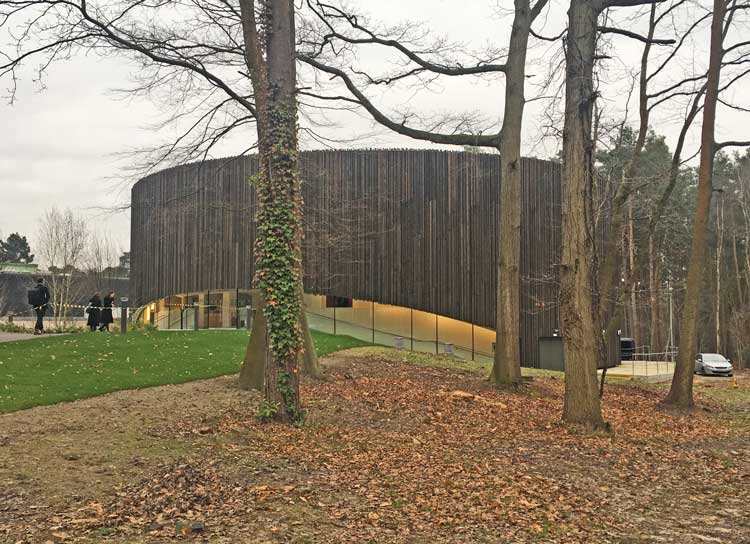
GW Annenberg Performing Arts Centre, Wellington College, Berkshire UK, 2018. Photo: Veronica Simpson.
It takes confidence, talent and huge determination to deliver such buildings. That must have been what Rafael Viñoly, the Uruguayan-born, New York-based starchitect (who died earlier this year), saw in his young associate when, in 2000, he suggested she set up an office for him in London. He made that offer to keep her on his team after she announced she was leaving to join her then fiance, now husband, in the UK. But she was only 29, and Viñoly was barely known in London, so it took huge trust, which was repaid in spades when Seilern secured him several new projects, the most notable being the well-loved Curve Theatre in Leicester and the more controversial Walkie Talkie building, 20 Fenchurch Street, in London (of which, more later). In 2006, long before the latter was finished, she had left to set up her own office, Studio Seilern Architects (SSA).
Seilern has, until now, kept a fairly low profile, steadily plying her trade within the highly competitive UK architecture scene despite the profession’s evident and historic bias against women: its massive inequalities in pay, recognition and opportunities started to be redressed only from about 2018.
Being Swiss-Austrian, and having grown up in Switzerland, then studied in the US, perhaps she shared with another notable UK-based female architect, Zaha Hadid, the outsider’s enviable lack of concern about how she was perceived. She simply pushed on, creating good and great buildings, ranging across residential, education and commercial.
Her skills didn’t go entirely unnoticed: a stunning forest home in Zimbabwe won her the World Architecture News (WAN) House of the Year in 2012 and the Royal Institute of British Architects (RIBA) International Prize for architecture in 2013. But then 2022 brought a deluge of gongs, including Architect of the Year in the Female Frontier Awards run by WAN.
The industry accolades follow on the heels of four remarkable projects completed in the last four years: the Andermatt concert hall (2019) was the first. Here, she managed to stay within the footprint of an unprepossessing basement bunker at the back of a hotel in what was then the Swiss Alps’ newest, and least famous, leisure resort. But knowing the clients’ ambition for this to be truly a cultural destination, she pushed for a much more ambitious design - acoustically and aesthetically - to create a modestly scaled but sculpturally delightful concert hall that was (as she promised) good enough to have the Berlin Philharmonic play its opening concert.
In 2021, she unveiled the exquisite private villa she designed as her own family residence in Paros, Greece, organised as a series of simple rooms around a poolside courtyard, resting lightly in the landscape.
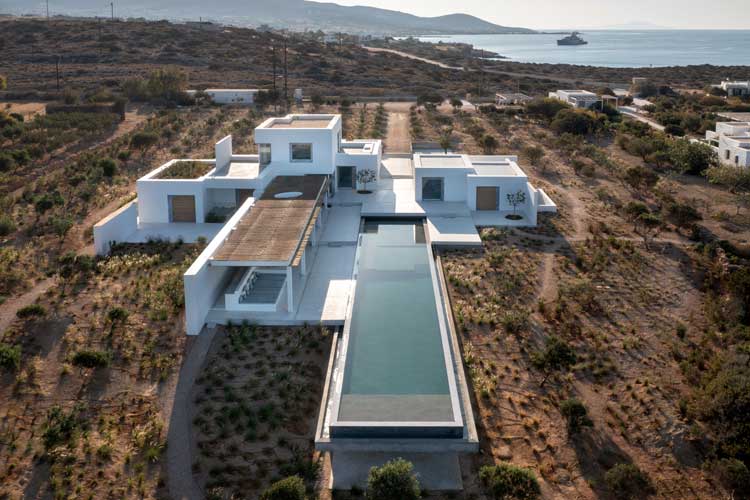
Seilern family residence in Paros, Greece, 2021.
In March 2022, the first phase of her El Gouna conference and cultural centre, a unique performance and public plaza surrounding an artificial lagoon, with an outdoor arena for 1,400, opened in Egypt. She is awaiting the go-ahead to start construction on an additional 900-seater concert hall and then a conference centre, all of which are intended to bring high-end tourism to this new city in the sand. She was brought into this scheme by the same client for whom she wrought miracles in Andermatt, the Egyptian-born developer Samih Sawiris.
In September 2022, her work – begun in 2008 – on a complex of ancient buildings in Vilnius completed, Boksto 6, showing that the flair she has for conjuring new buildings that enhance their surroundings could also be deployed to breathe new life into an ancient Cardinal’s palace.
We spoke in her office in west London as well as via Microsoft Teams.
Veronica Simpson: I remember you telling me in 2019 about El Gouna, which seemed a remarkable scheme. And now it is completed. What has been the response to this open-air plaza and public performance space?
Christina Seilern: They have been using it for film festivals and squash tournaments and weddings.
VS: Has it changed the kind of visitors they get?
CS: It’s early days. El Gouna is still really a brand-new place. But there are already 20,000 permanent residents, and visitors in the millions.
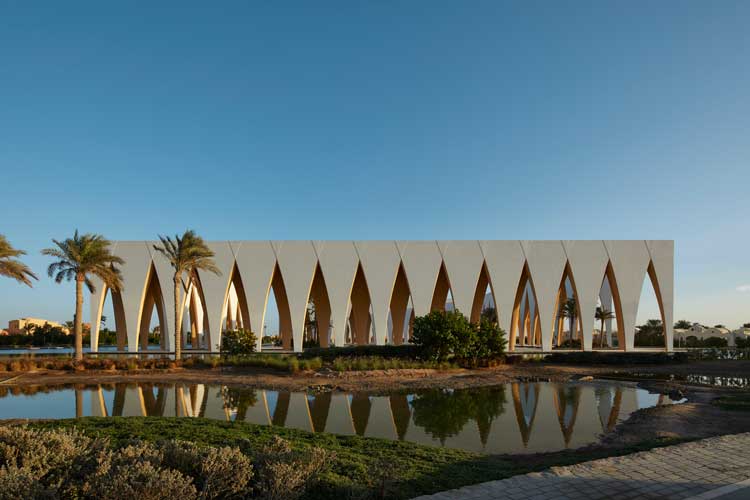
El Gouna Conference and Cultural Centre, Egypt, 2019. Photo: ©
Paul Riddle.
VS: I remember you describing it as a kind of Venice in the Middle East, built around lagoons, but you said you were also trying to use that waterside setting to be more sustainable than the typical development in the region. Has it lived up to that ambition?
CS: I think the attitude has changed a lot in the last 10 years. When they started, in 1990, nobody was really talking about that.
If you look at Google Earth pre-El Gouna and post, it was a desert then. But they found natural wells and created a development around lagoons. And even our body of water, which is 30,000 sq metres is naturally gravity fed, there’s not one pump in it. It’s a very natural way of doing it.
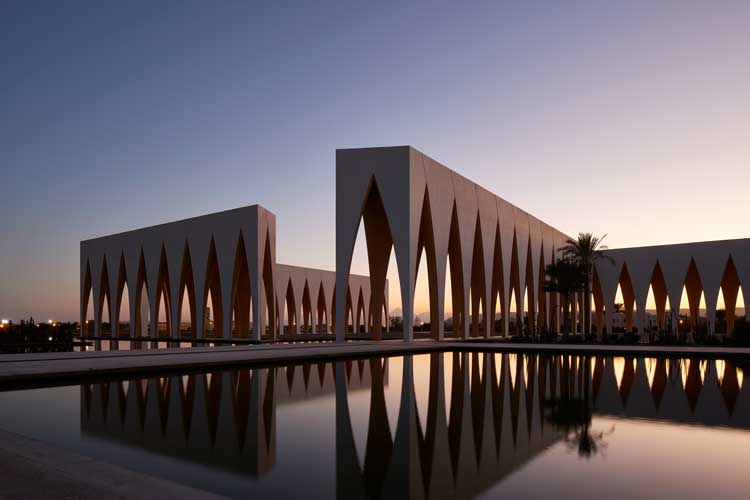
El Gouna Conference and Cultural Centre, Egypt, 2019. Photo: © Paul Riddle.
What’s more, the lagoon is cooling, it’s creating a microclimate. When the wind moves over the water it naturally cools the plaza. So, there’s an environmental reason behind it already. It’s part of the water system and it goes back into the water system. I think they are a lot better at what they’re doing now than when they started, but that’s normal, right?
VS: Your client Samih Sawiris has demonstrated in Andermatt, too, the benefits of slow and strategic regeneration.
CS: The difference with Samih is that he’s not a developer who does buildings, he does cities. He will never go to a place that is already established and where land values are high. He goes somewhere nobody wants to go and creates a destination. And that’s really the economic model. To do that, you have to create these destinations.
M.Rittershaus.jpg)
The Berlin Philharmonic playing at the opening of the Andermatt Concert Hall, Switzerland, 2019. Photo: M Rittershaus.
VS: There’s another remarkable, slow regeneration project that you have just brought to fruition in Vilnius. Can you walk me through how that happened?
CS: Vilnius finished last year but we’ve been waiting for the right moment to show it to people. This is a project I started in 2008. We’re restoring a large Unesco heritage site in the middle of the capital. It’s the most extraordinary story.
The clients are three brothers from Switzerland who, when the Berlin wall came down, decided to move to eastern Europe and try things out. One spoke Russian and had studied Russian and Chinese literature, and was sent ahead. He said Poland had too many mafia and other places were too rough, but Lithuania was small and manageable. They set up all these different companies and some took off and some didn’t. They then set up a supermarket business, which did really well and they sold it to one of the big French supermarkets. Essentially, they then bought this piece of real estate, which is an old cardinal’s palace, and decided to restore it.
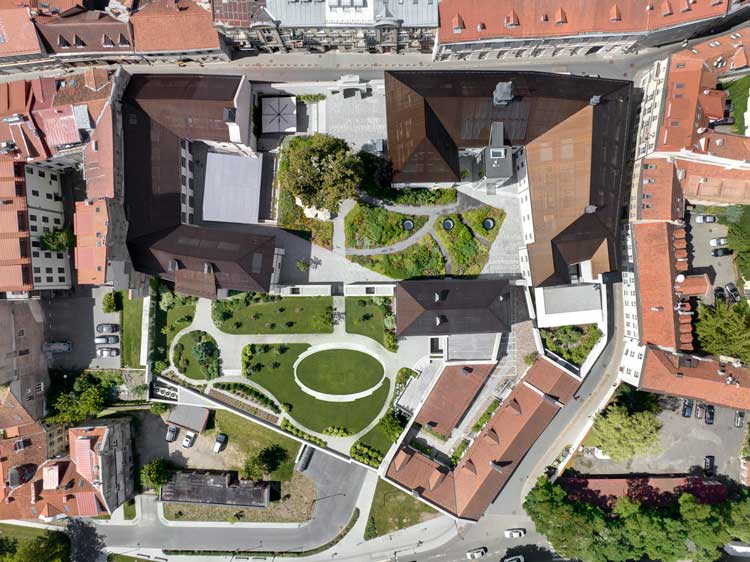
Boksto 6, Vilnius, Lithuania, 2020. A mixed use residential, office, restaurant and event complex created from a derelict cardinal's palace in the heart of Vilnius' old town.
When I came on board, they didn’t know what to do with it. They tried to do a hotel but couldn’t get permission. Then, in the global financial crisis of 2009, Lithuania suffered particularly badly (its GDP fell by nearly 15%) and even the airport at Vilnius closed down. It’s a fascinating story. Through trial and error, we found what this project wanted to be: mixed use and some public functions so that people from the centre could come and enjoy it. They weren’t like developers who are looking for a return. They were asking: “How do you give back to the country socially as well as environmentally?”
But it is extraordinary in another way, because we completely changed the planning regulations in the country to make this project happen. The local architects said: “You’ll never get planning for anything you’re asking for.” I felt that what we were doing was so right that I wasn’t going to do what the planners wanted.
I found a young Lithuanian architect, who was brilliant. He translated everything we were proposing. We went and presented to the planners. Remember, we are in Lithuania, which was a communist-occupied country until 1991. The people we were dealing with, 50% women and 50% men, all had PhDs. They were hugely educated, hugely smart, but totally not exposed to the wider world. I explained what we were doing. Showed the rationale. Then they said yes to everything.
I always say that doing a project is like writing a book. And DH Lawrence said that sometimes you have to trust the story and not the author, and see where the story takes you. This is an example of that.
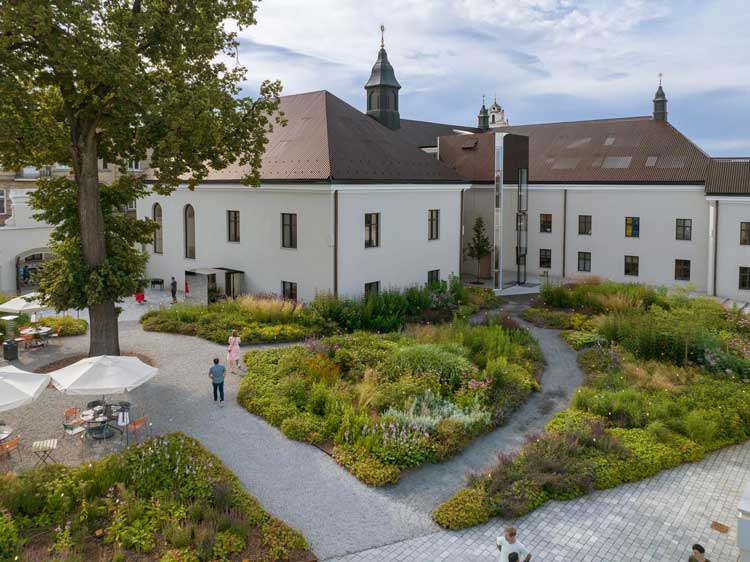
Boksto 6, Vilnius, Lithuania, 2020. The gardens are open access to the public, and the far building houses high quality office space from ground level, while below ground in the medieval vaults is a luxury spa. The chapel, on the left, is now an event space.
VS: What were the main objections?
CS: They wanted clay roofs and for me to put Velux windows everywhere. Velux windows were radical 50 years ago, but to do that would be to take your Baroque composition of a solid base and a solid roof and totally screw it up because it’s put all these pimples on it. And it’s reflecting the sun and it’s a terrible thing. What we’re doing is putting the Velux windows behind a metal mesh that doesn’t reflect the sun, and suddenly you have your Baroque composition, so it has this very historical precedent but presented in a contemporary manner. I suggested we let our new buildings reflect and pay homage to the historical but be contemporary.
First, it was a Polish cardinal’s palace, then it became a Carmelite monastery and then it became a VD hospital during the Soviet times. So, you had the classicism, then the Baroque, then the gothic, then our intervention. You can see this layering of history.
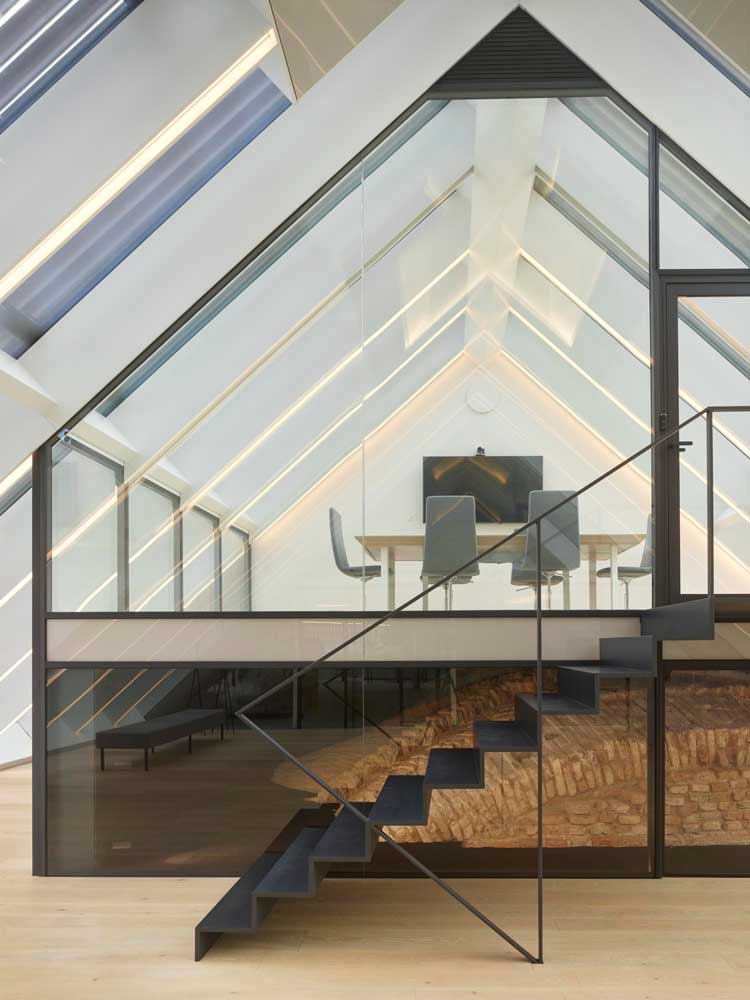
Boksto 6, Vilnius, Lithuania, 2020. A top floor office space. Seilern persuaded the planning office that windows could be incorporated into a smooth roofline, with a metal protective grille unifying the roofscape.
VS: Does your practice do competitions? I am intrigued about the generation of work.
CS: I try not to do unpaid open competitions. If the client has invested, the chances of the work happening are greater. If not, they’re just fishing for ideas. We’re such idiots as architects, we give out our work for free. Dentists don’t do it. Lawyers don’t do it. Why are we giving our intellectual property for free? For example, we just did a competition in Saudi, but they’re properly paid. It’s not: “Here’s £1,000 towards some pocket money, or paying your rent.” It’s paid like a proper job. We do invited competitions. We did one for Somerset House. But that’s a typical example. They paid nothing, there were 10 firms, each firm spent a fortune doing it, then nothing happened. It’s really a bit naughty.
VS: It’s also been a tough market in which to be a female architect leading a firm, though there has been some progress. Is Britain now better or worse than anywhere else for acknowledging female architects?
CS: I find it really hard to get jobs in the UK. It’s much more of a man’s club. The big developers go to three, four or five guys that churn out the same stuff. And I find that I’ve been getting a lot more respect in Saudi and Egypt and places like that. They respect that you’re a professional, you’ve gone through this education. When you’re talking, they’re listening and it’s much more respectful.
Generally, in the UK, when I tell people I’m an architect, I still get the question: residential? It’s always the first question. I say: “Yes, that too, but also concert halls and whatever.” And they go: “Oh, so the interiors?” Then, when they see that you can do the work, you get more credit than men, and that’s also wrong, that also annoys me.
VS: Where do you look for inspiration, for visual delight or when trying to resolve problems. What things, people, or spaces inspire you?
CS: For my mother’s 80th birthday recently, I made a little speech. My mother was an art dealer. When we grew up, she would drag us to Assisi and museums and she would have museum shows – she dealt with the Marina Picasso collection – and she would drag us to Australia, everywhere, with her. We were exposed to all that. And I thank her for the visual education. You have this catalogue of ideas that accumulates over time. When I was doing El Gouna, I said OK, the arches are a Moorish invention, then there’s the scale of architecture in Egypt, and the reason the arches are so big is because Egyptian architecture is on such a grand scale. For the six months I was designing it, all I saw were columns and arches. You have this catalogue of things and when you start playing with an idea you can really delve into this archive, and it emerges from that. But ideas come a lot easier as you get older. That’s why I think architecture is an older person’s skill. Louis Kahn or IM Pei said you only become an architect when you’re 50. And I was like, “Oh rubbish, rubbish,” and when I turned 50, I thought: “Hmmm, maybe.”
VS: What got you started on the path of architecture?
CS: I think it was going to America. I grew up in Switzerland, in the mountains with chalets and cuckoo clocks and then going to America and seeing the scale. I was incredibly lucky to study in America. Arriving in Boston, I’d never seen a skyscraper. I took one class of architecture at MIT and that was it. I originally went there to study science, molecular biology.
My father had said to my brother and me: “You should either be an architect or a journalist.” And I was a rebel, so I thought I’ll never be either. Then I took one class and thought, he was right.
VS: It is interesting that the thing that brought you over here – or at least put Rafael Viñoly Architects on the UK map, is the Walkie Talkie building. How do you feel about that project now?
CS: When I look at it, it looks like somebody’s put on too much weight. When we did the planning, it was much more slender. Then Canary Wharf (developers) came on board, and it shifted.
The majority of my projects are abroad and that’s not by choice. It’s because this is where the work is, the interesting work. Because I want to go after the interesting work - the things where we can use our creative minds and push the envelope a bit further. It’s not that there is no work in the UK, but it’s very monopolised by a few offices and it feels quite formulaic. I have been in meetings with developers who say: “Yes, what you do is so beautiful, but do you do anything normal?” There is a bit of that. When we look at public jobs, performing arts venues and we go to the public tender list, it seems everything is in France and Germany and a bit of Italy and very little in the UK.
VS: Where are you excited to be working right now?
CS: We are doing this huge residential project in Connecticut. We’re always doing residential projects, but we don’t really talk about them too much. It’s for a woman who wanted to build a great piece of architecture. The client wants almost a family campus, because they have a lot of family around and she even wants to do a sports complex for friends and the grandchildren, so it’s quite a piece of architecture. it’s 45,000 sq ft.
She had never seen anything we’d done. She just knew that I did beautiful concert halls. Her girlfriend was a friend of mine. We met at lunch. She is already doing two other projects, all female architects - Annabelle Selldorf, India Mahdavi. But this is the only newbuild, the others are fit-outs. She gave the greatest project to the most unknown of the three. She just wanted to do something different. And I really appreciated this confidence. And it’s great fun. It’s great fun to do.
Then we have a lot of projects in Greece because we have a small office in Greece. We have had it for three years. And now we’re opening an office in New York to deal with this residential project.
But I think London is such a hub, so it’s easy to work abroad. Also, you have the best consultants and the best minds here, so we’re all sitting together, and feeding off each other. This cross-pollination is important.
VS: Is there any unrealised project you would love to do?
CS: I don’t know why, but ever since I was a student, I have wanted to do an airport. But one day – one day, mark my words - I’d love to do one.
VS: Which airport building do you think triggered that desire?
CS: I don’t know, probably (Eero Saarinen’s) TWA. It was always this fascination with the dynamics, the movement. And I spend so much time in airports. So – one day!